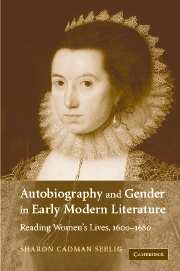Book contents
- Frontmatter
- Contents
- Preface
- Introduction: mapping the territory
- 1 Margaret Hoby: the stewardship of time
- 2 The construction of a life: the diaries of Anne Clifford
- 3 Pygmalion's image: the lives of Lucy Hutchinson
- 4 Ann Fanshawe: private historian
- 5 Romance and respectability: the autobiography of Anne Halkett
- 6 Margaret Cavendish: shy person to Blazing Empress
- Conclusion: “The Life of Me”
- Notes
- Bibliography
- Index
Preface
Published online by Cambridge University Press: 22 September 2009
- Frontmatter
- Contents
- Preface
- Introduction: mapping the territory
- 1 Margaret Hoby: the stewardship of time
- 2 The construction of a life: the diaries of Anne Clifford
- 3 Pygmalion's image: the lives of Lucy Hutchinson
- 4 Ann Fanshawe: private historian
- 5 Romance and respectability: the autobiography of Anne Halkett
- 6 Margaret Cavendish: shy person to Blazing Empress
- Conclusion: “The Life of Me”
- Notes
- Bibliography
- Index
Summary
My awareness of seventeenth-century women's writing began with poetry (by Mary Wroth, Katherine Philips, and Aemilia Lanyer), with drama (by Elizabeth Cary), and with fiction (by Aphra Behn and Margaret Cavendish). But my interest in a wider variety of texts was awakened by the brief selections of first-person narratives in the volume entitled Her Own Life and by the larger, complete texts made available, first in hard copy and later online, by the Brown Women Writers Project. And gradually I turned to nonfiction prose – to diaries, memoirs, and other autobiographical texts – as forms of self-representation and as a window on a period I had long studied with attention to its male writers. Along the way, I met with occasional discouragement. In 1996, while on sabbatical in Europe, I was poring over the diary of Lady Margaret Hoby in somewhat constrained working conditions. Our sixteen-year-old son, looking over my shoulder at the text, and aware that pleasure as well as work should attend such a leave, said, “You're on sabbatical, right? You could read anything you want, right?” Then, in response to my affirmative, he said, “I think that's just sick.” We've continued that conversation since, and though I can't claim to have converted him to the reading of early modern women's diaries, I'm the more inclined to explain why I keep reading these texts and what I think can be learned from them.
- Type
- Chapter
- Information
- Autobiography and Gender in Early Modern LiteratureReading Women's Lives, 1600–1680, pp. viii - xPublisher: Cambridge University PressPrint publication year: 2006

